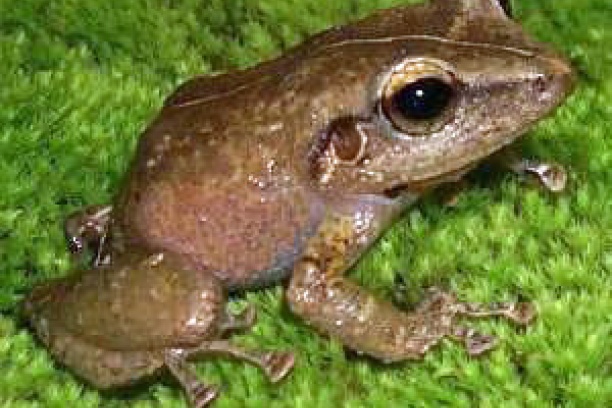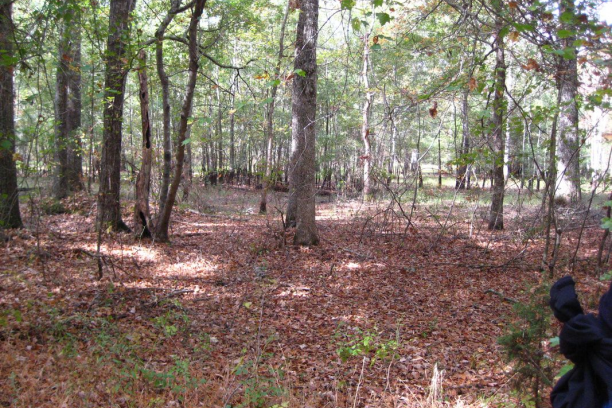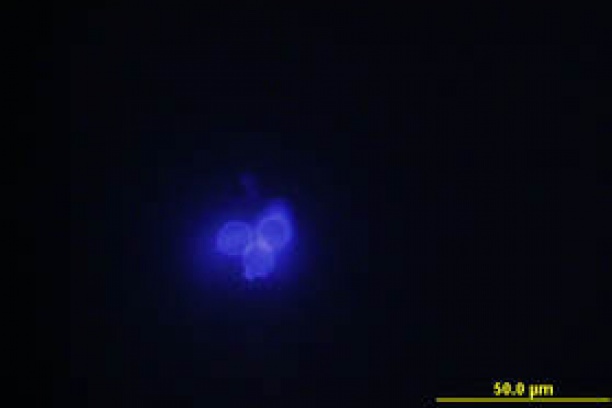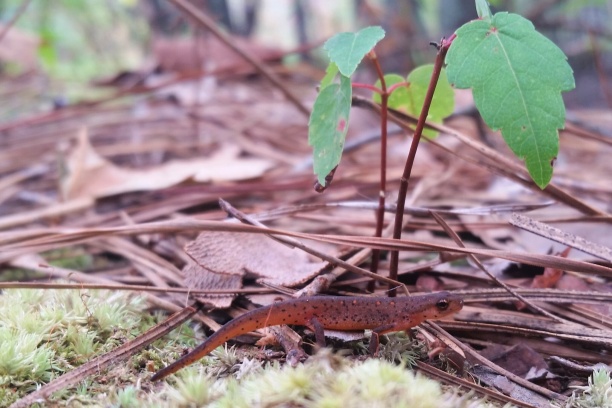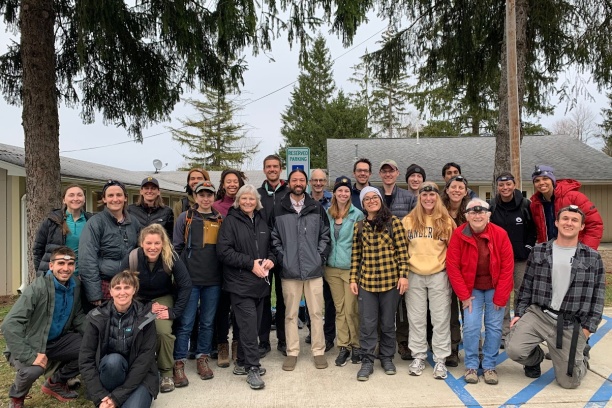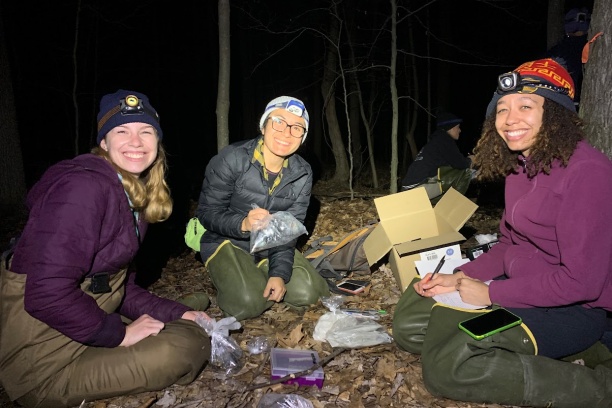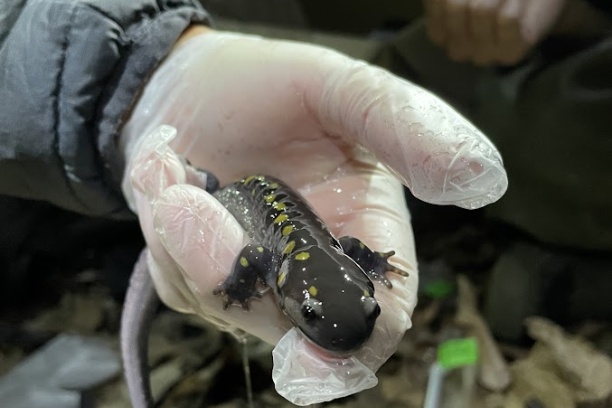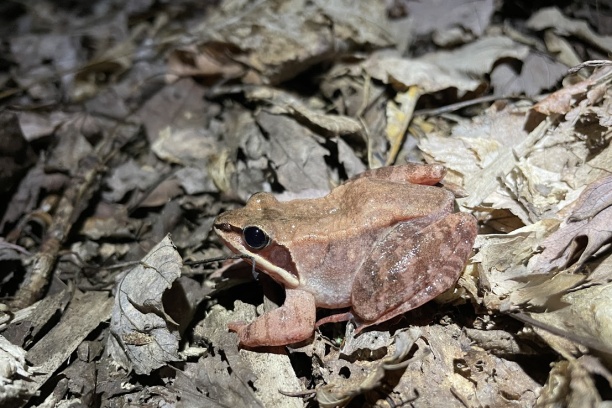- Effects of Climate on Host/Pathogen Interactions in Chytridiomycosis:
Chytridiomycosis, a disease caused by Batrachochytrium fungi, has recently caused declines and extinctions of amphibian populations on several continents. With collaborators at other institutions (U. Pittsburg, U. Mass Boston, U. Nevada Reno, UC Santa Barbara, UC Berkeley), our central objective is to develop predictive models of chytridiomycosis, based on a clear understanding of how climate impacts the ecology and dynamics of this host-pathogen interaction, and use them to investigate the potential impact of alternative management tactics. Given the potential impact of climate change on disease risk, studies of this nature may be critical in developing strategies to promote the long-term health of threatened amphibians and other wildlife on Department of Defense (DoD) lands. To investigate how climate impacts the ecology of chytridiomycosis, we sample amphibian communities for Batrachochytrium dendrobatidis (Bd) and Batrachochytrium salamandrivorans (Bsal) at at DoD installation in Tennessee. We continue to assess seasonal patterns of pathogen prevalence and load, and anti-Bd immune defenses in amphibian hosts.
- Host and Pathogen Interactions in the Amphibian Disease, Chytridiomycosis:
Fungal infections in wildlife are a growing concern. Batrachochytrium dendrobatidis (Bd) is a skin fungus that is one cause of worldwide declines and extinctions of amphibians. A second pathogenic species, Batrachochytrium salamandrivorans (Bsal), has recently been discovered. Fungi that infect vertebrates have complex interactions with their hosts, and host immune defenses generally keep them in check. However, many pathogenic fungi have developed immune evasion strategies. With previous NSF support, we have learned much about the immune defenses of amphibians that give them some protection against Bd. With this project, we direct our attention to efforts to understand why the immune defenses against Bd are often ineffective. Our initial studies demonstrated that Bd does not impair phagocyte recognition and processing, but instead, it releases immunotoxic factors which target effector lymphocytes by induction of apoptosis. Key questions: What are the chemical structures of the fungal toxins? What are the mechanisms of pathogenesis? Are B and T lymphocytes equally affected? Are other non-lymphoid cells targets of Bd factors? Given the genomic diversity of Batrachochytrium, do all species and isolates produce immunotoxic molecules? Does Bsal have the same ability to inhibit lymphocyte mediated responses?
- Transmission Pathways and Immunological Factors Driving Invasion Potential ofBatrachochytrium salamandrivorans:
This project is designed to study chytridiomycosis caused by a second chytrid fungus, Batrachochytrium salamandrivorans (Bsal). The disease is thought to have developed in Asia and accidentally introduced in Europe where it has killed populations of fire salamanders. North America is home to a great variety of unique salamander species, and there is great concern that this pathogen would devastate many species. The research will focus on an abundant aquatic newt found through the eastern United States (Notopthalmus viridescens) and study how the disease may be transmitted and what immune defenses newts may use to protect themselves. At present, Bsal has not yet been detected in North America, but there is great concern that it may be accidentally introduced and impact many North American salamander species.
- Defining the role of skin microbiomes in defense against chytridiomycosis in frogs with seasonal infections:
Amphibians (frogs, toads, salamanders) are important members of many natural animal systems. They consume algae and aquatic plants as tadpoles and consume insects as adults. In turn, they are prey for birds, snakes, and small mammals. Amphibians are currently declining due to a lethal fungal skin disease named chytridiomycosis. Chytridiomycosis is caused by Batrachochytrium fungi. One Batrachochytrium fungus, B. dendrobatidis (Bd), is widespread in the US and around the globe, and it has been associated with the population declines as well as extinctions. Previous studies have shown that temperate/tropical frogs are more susceptible to Bd infection at different times of the year. While amphibians possess a robust immune system, an additional component of immunity is the skin microbiome (communities of bacteria on the skin surface), which may be effective against Bd infection. Not only are the immune system and skin microbiome critical in disease dynamics, but seasonal changes and habitat diversity are also key players in this complex relationship. In light of this, the study aims to define the role of skin microbiomes as a functional component of host immunity in frogs persisting when the pathogen dynamics change with seasons. This study will focus specifically on the Coqui frog, Eleutherodactylus coqui, a beloved frog found in Puerto Rico.
- Biology Integration Institute (BII): “Resilience Institute Bridging Biological Training and Research (RIBBiTR):”
The institute encompasses nine academic institutions and thirteen senior investigators using field and laboratory studies to investigate how amphibian species are developing long term resistance to the fungal disease called chytridiomycosis that has caused decades-long declines in amphibian populations around the world. The good news is that some populations and some species of amphibians appear to be recovering, and our institute will continue to monitor and investigate the biological mechanisms that support these recoveries.
- Defining the Interactions between Amphibian Skin Immune Defenses and a Deadly Chytrid Fungus:
In this project, we propose to define the interactions between macrophage subsets residing in amphibian skin and the pathogenic chytrid fungus Batrachochytrium dendrobatidis (Bd), a leading cause of global amphibian declines. Recent studies indicate that Bd-challenged animals exhibit highly dysregulated skin immune responses, which may be partly due to immunomodulatory factors produced by this fungus. Because macrophages of all vertebrates are important to immune system function, we propose that the frog skin macrophages play critical roles during Bd infections and may determine the host survival outcome.
Check out our Facebook page and Wordpress site, "Frogs in Peril: The Battle in the Skin," for updates!
